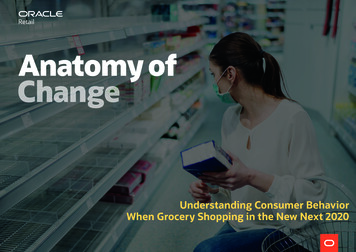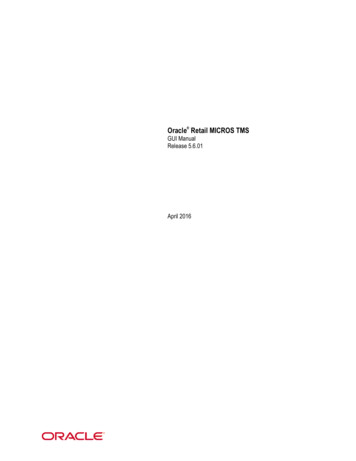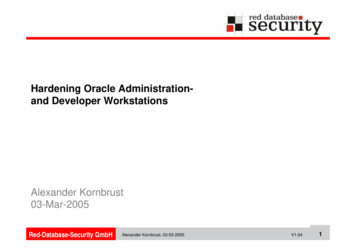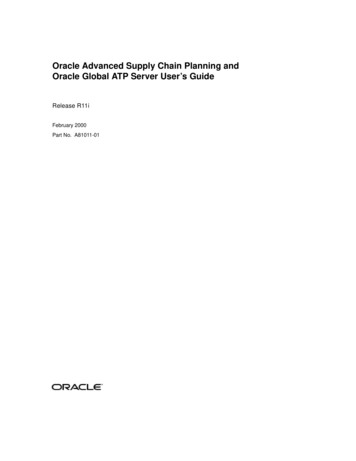
Transcription
RetailAnatomy ofChangeUnderstanding Consumer BehaviorWhen Grocery Shopping in the New Next 2020
Anatomy ofMethodologyThe research cited in thisreport was conducted in2020 with more than 5,143consumers across four keyregions, including Europe(France, Germany, Italy,United Kingdom, UnitedArab Emirates), APAC(Australia, China), LATAM(Brazil, Mexico), and NorthAmerica (United States ofAmerica).ChangeIndependent research andcreative consultancy UntoldInsights conducted theresearch on behalf of OracleRetail, which exploresconsumer attitudes andexpectations regarding theretail shopping experiencenow and in the future.This report is based onthe findings from thisstudy, with a focus on thegrocery market.Understanding Consumer Behavior WhenGrocery Shopping in the New Next 2020IntroductionUnlike any other year in recent history, 2020 has seen consumer behavior, and by extension, the retailmarket, significantly disrupted. Global public health measures in response to the COVID-19 pandemic quicklyand dramatically affected not just consumers’ ability to shop in physical locations but also their desire to.Grocery stores, deemed “essential businesses” and not subject to long-term closure, have nonetheless feltthe significant effects of shifting consumer behaviors, perceptions, and expectations on retailers.This report examines key impacts of the COVID-19 pandemic on consumer behavior — includingpermanent changes in consumer shopping habits, ongoing challenges in maintaining the grocery experience,and consumer exploration of new brands. It also explores what these changes mean for the future ofgrocery retail.World map regions, indicated by color,LATAMcorrelate to the list of countries included- Brazilper area surveyed.- MexicoNorth America: United States of AmericaLATAM: Brazil,MexicoEurope- FranceEurope: France,Germany, Italy,United Kingdom,United Arab Emirates- Germany- Italy ChinaAPAC: Australia,- United Arab EmiratesJAPAC- Australia- China2Anatomy of Change: Understanding Consumer Behavior When Grocery Shopping in the New Next 2020
A New Era in GroceryShoppingAs the global pandemicshut down communities,consumers began shoppingdifferently — even with“essential” businesseslike grocery stores, whichremained open to the publicfor in-person shopping.Notably51%51%of respondents said they had rarely or never shoppedonline for groceries before the pandemic began.Despite being able to shop in-store, 61% of consumers reportedmaking grocery purchases online during the pandemic. Of these,41% of consumers reported shopping online more often than in-storeprior to the pandemic, and 20% shopped in-store more frequentlythan online.3Anatomy of Change: Understanding Consumer Behavior When Grocery Shopping in the New Next 2020
How people shop during the pandemic:4Havepurchasedgroceries onlineShoppedmore onlinethan in-storeShoppedmore in-storethan online67%41%20%90%72%18%Shoppedonline natomy of Change: Understanding Consumer Behavior When Grocery Shopping in the New Next 202062%UAE52%FranceIn the months since COVID-19 lockdowns began to change behavior,consumers have formed new habits. In fact, 92% of consumerssurveyed will continue online grocery shopping moving forward, with7 in 10 consumers anticipating they will shop online as much as ormore frequently than they have during the pandemic.Overwhelmingly, consumers who bought groceries online hadthem delivered, with nearly 3 in 4 consumers opting for homedelivery. Just 16% chose to pick up groceries in-store, and 11%chose curbside pickup to collect their grocery purchases.The shift in consumer behavior also drove the adoption of mealsubscription services. More than 1 in 5 consumers started one ormore new food or meal subscription services, and 7% of consumerstried a subscription service for the first time.
Beyond safety, the researchshowed that 47% of globalrespondents said out-ofstock merchandise toppedtheir list for a bad shoppingexperience. Additionally,63% said they weren’twilling to wait for an itemto be back in stock beforetrying another brand.5Anatomy of Change: Understanding Consumer Behavior When Grocery Shopping in the New Next 2020of consumersBeyond relying on reviews and responsible public health measuresto drive grocery decision-making, consumers also base shoppingdecisions on a factor that hasn’t been changed by the pandemic:shopping rewards. Despite trying new brands when inventory islacking, nearly 30% of consumers say they would always choose agrocery retailer where loyalty points or discounts on purchases areavailable, versus other options. Nearly 9 in 10 consumers (88%) saythat they would sometimes, frequently, or always choose groceryretailers where these types of rewards are available, with just 11%saying that rewards and discounts rarely or never affect their choiceof the grocery retailer.Aspects of theconsumer experiencerated as important orvery important:Contactless checkout (66%)71%71%Consumers also relied on others’ experiences to inform theirshopping choices online and in-store. Nearly 9 in 10 consumers(89%) stated they were moderately or very influenced by bad reviewsof a product or a store’s service. This reliance on peer inputs hassignificant potential impacts, as less than 25% of consumers rarelyor never leave negative reviews after a bad product or shoppingexperience.Reduced foot traffic in-store: 76%The shopping experiencecontinues to be a significantdriver of consumerpreference. The speed ofcheckout remains a priorityfor 71% of consumers, aswell as knowledgeableand intelligent staff (57%).In addition, consumersshopping in stores duringthe pandemic had newexpectations for theshopping experiencefrom all retailers.Checkout speed a priority forVisible cleaning efforts: 82%Maintaining theGrocery Experience
Private Label BrandDiscovery During thePandemicRetailers should take noteof the critical role thatinventory management canplay in maintaining brandloyalty. High demand forpantry staples and otheressential items often madeproducts difficult to find,both online and in stores.Nearly2/3of consumers (64%) chose to purchaseproducts at another store or opted topurchase another brand rather thanwaiting for a product to be restocked.Of consumers that explored new private label brands in-store,more than half (61%) plan to stick with the new brands or includethem in a mix of new finds and old favorites as they shop in thefuture. And of those that purchased products at new grocery stores,53% plan to continue shopping at the new locations in addition totheir prior preferred stores.Also interesting to note that consumers in UAE (93%) andChina (90%) were the most adventurous in trying new privatebrands, while Germany (63%) and France (67%) were lessreluctant to explore them.6Anatomy of Change: Understanding Consumer Behavior When Grocery Shopping in the New Next 2020
With grocery shortages during COVID, did you explorestore own brands/private labels?7discovered newbrands onlineAnatomy of Change: Understanding Consumer Behavior When Grocery Shopping in the New Next 2020Italy: 88%UAE: 93%China: 90%Brazil: 88%USA: 86%Mexico: 87%Many consumers unable to find what they needed in thestore turned to online storefronts and new brands to meettheir grocery needs. In fact, nearly half of consumers (45%)discovered new brands online and will continue to shopfor those brands moving forward, with 16% anticipatingchoosing the new brands over their former preferred brand.France: 67%Australia: 78%UK: 87%Germany: 63%Breakdown by Country45%45%
ConclusionThe face of grocery shopping, as we know, it has been forever changed by the COVID-19 pandemic.Agility and adaptability are critical to the health of grocery businesses. Consumers have newexpectations of retailers that go beyond the availability of products and the usual quality of in-store andonline experiences. There is greater pressure on retailers to reassure in-store consumers are safe andthat their time in-store is brief and efficient.There is also a growing imperative to manage stock online and in-store to ensure that the productsconsumers need are available wherever they shop. But, with stockpiling behaviors creating newinventory management challenges for grocers, brand and store loyalty is up for grabs.As we enter 2021 and beyond, grocery retailers will be challenged to maintain the quality andconsistency of shopping experiences, no matter where they occur.See More on How Consumer Habits Have Shifted8Anatomy of Change: Understanding Consumer Behavior When Grocery Shopping in the New Next 2020
About Oracle Retail:—Oracle is the platform for modern retail. Oracle provides retailers with a complete, open, and integrated platform for leading retail solutions, cloudservices, and hardware that are engineered to work together. Innovative retailers use Oracle solutions to pivot to customer and to drive agility acrossthe business. Oracle Retail customers can deliver an authentic customer experience while protecting their people, processes, brand, and customers.For more information, visit our website.CONNECT WITH USCall 1.800.ORACLE1 or visit oracle.com. Outside North America,find your local office at com/company/oracle-retail/Copyright 2020, Oracle and/or its affiliates. All rights reserved. This document is provided for information purposes only, and the contents hereof are subject to change without notice.This document is not warranted to be error-free, nor subject to any other warranties or conditions, whether expressed orally or implied in law, including implied warranties and conditionsof merchantability or fitness for a particular purpose. We specifically disclaim any liability with respect to this document, and no contractual obligations are formed either directly orindirectly by this document. This document may not be reproduced or transmitted in any form or by any means, electronic or mechanical, for any purpose, without our prior writtenpermission.Oracle and Java are registered trademarks of Oracle and/or its affiliates. Other names may be trademarks of their respective owners.Intel and Intel Xeon are trademarks or registered trademarks of Intel Corporation. All SPARC trademarks are used under license and are trademarks or registered trademarks of SPARCInternational, Inc. AMD, Opteron, the AMD logo, and the AMD Opteron logo are trademarks or registered trademarks of Advanced Micro Devices. UNIX is a registered trademark ofThe Open Group. 1120
53% plan to continue shopping at the new locations in addition to their prior preferred stores. Also interesting to note that consumers in UAE (93%) and China (90%) were the most adventurous in trying new private











